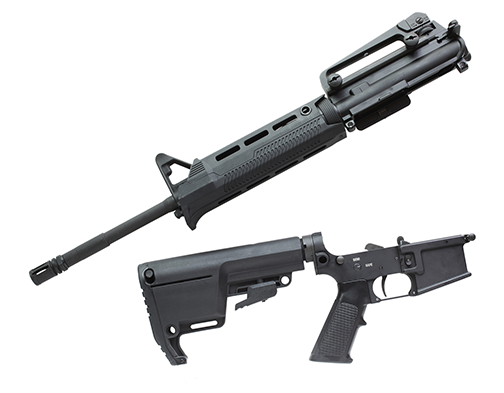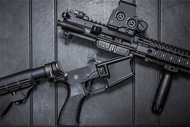The Beginner’s Buyers Guide: AR-15
The AR-15 is more than just a single rifle model; it is a family of firearms descended from the original ArmaLite AR-15 and the military M16 and M4. Statistics compiled by the National Shooting Sports Foundation (NSSF) estimated that U.S. civilians owned more than 24.4 million AR-15s and similar rifles, referring to them as “modern sporting rifles” (MSRs).
Hundreds of different companies and manufacturers produce AR-15s or parts compatible with it. Gun owners and enthusiasts in the United States can purchase complete rifles, parts kits, or individual components to build their own. With such a huge selection of AR-15s and related parts on the market, knowing where to start can be difficult, especially for a beginner.
At IFA Tactical, we have compiled this AR-15 buyers’ guide to help you get started, whether you are new to firearms in general or only to the AR.
Why Do You Need an AR-15?
The AR-15 is, above all else, an extremely modular rifle platform. It can be easily modified and reconfigured with basic tools to fit the shooter’s needs. Because the AR-15 can be adapted to fit nearly any shooting task, it is reasonable to ask yourself what role or purpose you need one for first.
A common saying in tactical and enthusiast circles is “mission dictates gear” and is the gun owner’s equivalent of “choosing the right tool for the job.” Adopting this principle can help you narrow down the right AR-15 for you. Depending on the configuration, the AR-15 is suitable for any of the following:
Self-Protection and Home Defense
If you are looking for a self-defense firearm, the AR-15 is one of the most effective choices. A typical AR-15 carbine is lightweight and accurate, produces low recoil, and its standard magazines can hold 30 rounds of ammunition. Most ARs accept 5.56 or .223 ammunition, which is considered highly effective for self-protection, especially with soft-point or hollow-point projectiles.
These traits make it easier for shooters of any skill level or stature to learn to use one efficiently in a high-stress situation, especially compared to a more powerful rifle or a shotgun.
Competition and Sport Shooting
Competition-oriented AR-15s play to the platform’s strengths. Their modularity, compatibility with various attachments, and generally lightweight construction make them an excellent choice for sport shooting. They are highly popular in disciplines like 2-Gun, 3-Gun, Precision Rifle Series, and rifle divisions in USPSA and IPSC.
Barrel lengths and accessories, especially optics, are typically selected depending on the engagement distance. Long-range disciplines favor long barrels and large scopes, whereas close-quarters disciplines favor shorter, lighter carbines with low-powered optics and red dot sights.

Hunting
Although regulations may vary significantly by state, county, and other local ordinances, the AR-15 is a popular choice for hunting everywhere it is legal to use one. In standard calibers, such as .223/5.56, the AR-15’s natural accuracy makes it an excellent choice for hunting small and medium game, such as varmints and coyotes.
When chambered for alternative cartridges, such as .300 Blackout, .224 Valkyrie, or 6.5 Grendel, the AR-15 can even become an excellent deer or hog-hunting rifle.
General-Purpose Applications
While many gun owners customize and specialize their AR-15s for specific applications, many others aim for the jack-of-all-trades approach. Configuring an AR-15 to fit as many roles as possible is possible, opting for acceptable performance in as many scenarios as possible instead of optimal in just one. You can use the same AR carbine or rifle with the right components for self-defense, competition, hunting, and fun or plinking.
Regardless of the purposes you need your AR-15 for, all shooters should practice as often as possible to develop and maintain their fundamentals. There is no replacement for regular training and proficiency, regardless of your AR’s intended role or budget.
AR-15 Buyers’ Guide: Calibers
The original AR-15 rifle was chambered for .223 Remington. Its military counterpart, the M16, was designed for the military version of .223 Remington, 5.56x45mm NATO. While the vast majority of ARs produced since then have followed the same pattern, many alternative calibers were also developed for the platform.
Today, AR-15 barrels are available in a wide range of different cartridges. Converting a .223/5.56 AR-15 to a different caliber can be easily done by swapping out the gun’s top half, the upper receiver, for one with a different barrel. Below is a quick, non-exhaustive list of available calibers for AR-15s and their main traits and advantages.
| Caliber name | Traits and advantages |
|---|---|
| 5.56x45mm / .223 Remington |
|
| .300 Blackout (.300 BLK) |
|
| 6.5 Grendel |
|
| .224 Valkyrie |
|
| 6mm ARC |
|
| 7.62x39mm |
|
| .450 Bushmaster |
|
Should You Buy or Build?
Although many AR-15 buyers’ guides will recommend purchasing complete rifles, you can also build your own. Assembling your AR-15 from parts may seem daunting initially, but it is much easier than it looks due to the wide availability of parts kits and ready-made upper and lower receivers.
Buying a Complete AR: Pros and Cons
| Pros of Buying an AR | Cons of Buying an AR |
|---|---|
| Convenience. Buying your AR-15 like you would any other firearm is the quickest way to become an AR-15 owner. If you’re buying it in-store, you must pay for it and sign the ATF Form 4473. | Price. Although AR-15s are available in a wide range of prices for different budgets, buying a complete rifle is typically more expensive. |
| Customer support. Buying a ready-made rifle from a reputable manufacturer allows you to benefit from its customer support and warranty programs. | May not have every accessory you want. Purchasing an AR-15 means you’ll receive the furniture and accessories it came with. If it lacks anything you need or want to customize it later, you’ll have to buy parts separately and install them yourself. |
| Peace of mind. Buying a ready-made AR-15 means purchasing a rifle produced in factory conditions and passed quality control checks. You have the relative guarantee it will work out of the box. | Some new rifles don’t have essential parts. Many budget rifles are sold without rear sights. While the rifle is technically functional, it forces shooters to buy a separate part and install it themselves. |

Building Your Own AR: Pros and Cons
| Pros of Building an AR | Cons of Building an AR |
|---|---|
| Cost savings. Building your own AR-15 from a parts kit costs less than buying a complete pre-made rifle of equivalent quality. It’s a great way to save a few hundred dollars. | Technical skills. While the AR-15 is one of the easiest platforms an individual shooter can assemble by themselves, it still requires an investment in time and necessary skills. If you have never handled firearms before, building your own can be very challenging. |
| Full customization. A DIY AR-15 lets you choose every part and accessory you want, down to the pistol grips, stocks, handguards, and internals. It’s the best way to build a rifle that suits your exact needs. | Some tools may be required. Depending on the parts and kits you purchase, you may need tools and accessories to assemble your rifle. An AR-15 armorer’s toolkit should contain everything you need to assemble and customize any AR. |
| Unique experience. Assembling an AR-15 from parts by yourself lets you become familiar with your rifle more quickly than simply buying and maintaining it. | Legal aspects. Certain combinations of parts may not be legal to possess without the proper paperwork. For example, combining a barrel meant for an AR-15 pistol with a lower receiver fitted will result in assembling a short-barreled rifle (SBR). SBRs are federally regulated and require prior approval from the ATF to possess. Familiarize yourself with all local and federal laws before building an AR-15. |
Buy AR-15s and Shop AR Parts at IFA Tactical
Whether you prefer to buy a pre-made rifle or are looking to build your own, IFA Tactical stocks a large quantity of AR-15 rifles, parts, and accessories. Browse our online inventory or visit our Sterling Heights, MI, store to find or make the ideal AR for your needs, from hunting to competition, self-defense, or general use.
If you have any inquiries about the AR-15 or need more information beyond our AR-15 buyers’ guide, don’t hesitate to ask our team. We’ll answer all your questions and help you navigate your options.

